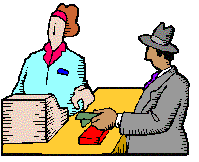
Considered consumer math (see Consumer Math Lessons), converting money values will be taught, as well as learning to give the correct change and receive the correct change after making a purchase (see counting money lessons).
When students enter fourth grade, the teacher will review the basic monetary values starting with the coins and dollars. This may take the teacher almost two weeks between review, exercises, and testing. Once the teacher feels the class is satisfactory in their knowledge of money values, symbols, and recognition, then they will begin the review of addition of different money values (see Money Math). The teacher will start with the coin values; for example $.25 + $.10 = $.35. Next will still use the coin values but will mix the coins together to make new values like $.93 + $.57 = $1.50. The reviewing of addition with money will last for one week; starting with the basic coin values and leading up through the dollar amounts. It may seem very basic but after the summer vacation, children need to review concepts that were just taught in the prior grade level.
Continuing with the review, the teacher will follow the same process as addition for the subtraction of money values. This review also will last a week starting with the basic coin values to the dollar amounts. Due to the monotony of these concepts, many teachers will create a game for their students. Some games can be played in a group of three to five students, partnered, individualized, or full class participation. Ideas for interactive learning games can range from a puzzle worksheet to a wheel of fortune type of game where all the phrases are money terms and the values on the wheel are math problems which must be solved before choosing a letter. The more creative a concept, the easier it will be for students to remember addition and subtraction of money.
What will be new in grade four is converting coin and dollar values. With addition and subtraction already learned, this standard should be fairly easy for students to learn. The reality is in kindergarten, the teacher had the students interactively converting the coins to different values when they played the shopping game. In fourth grade, the difference is the students will have to mentally solve the problems as if they were in the real world. This begins the teachings of finances and help students understand the value of money.
For example, the teacher may write certain money values on the front board and ask the students to copy them into their notebooks. Then they will ask them to write, in words, the different ways the one value can be achieved. The value $4.28 is written on the board. The teacher gives the students five minutes, individually at their seats to answer this problem. The teacher asks the class for participation and will write all the answers on the board to discuss each answer with the class. An example of one of the answers could be: three one dollar bills, five quarters, and three pennies. If the teacher finds this value too hard to begin with, they can lessen it to just coin values. Each class works at a different pace and it is up to the teacher’s discretion.
By requiring students to write in words the monetary values, this incorporates the new thinking of combining the subjects to allow more understanding of why English and Math must be learned in school or crossing the curriculums. The basics of multiplication and division of money are introduced and reviewed but the main focus in fourth grade is to teach students how money relates to the real world. They begin to understand the value and how the finance world works.
Go to Counting Money Worksheets and Lessons